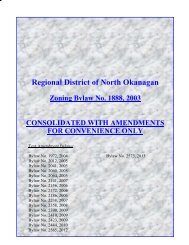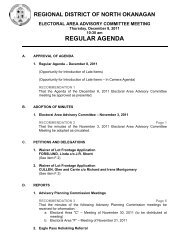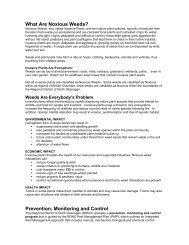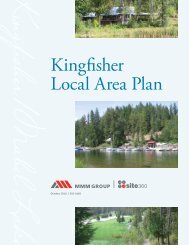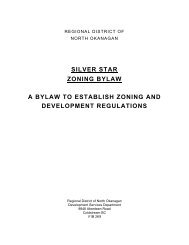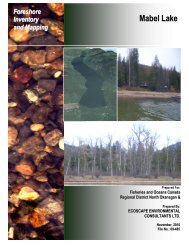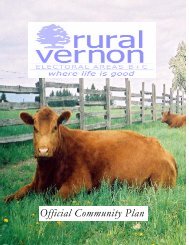March 2004 - Regional District of North Okanagan
March 2004 - Regional District of North Okanagan
March 2004 - Regional District of North Okanagan
Create successful ePaper yourself
Turn your PDF publications into a flip-book with our unique Google optimized e-Paper software.
Waste Matters<br />
<strong>March</strong>, <strong>2004</strong><br />
Local Society Short-Circuits E-waste<br />
What’s Inside...<br />
2<br />
A Look at<br />
Glass Recycling . . . .<br />
2<br />
Solid Solutions<br />
Leadership Award . .<br />
3<br />
Capital<br />
Upgrades . . . . . . . . .<br />
3<br />
Bylaw Bulletin. . . . .<br />
Recycling &<br />
4<br />
Disposal<br />
Facilities/Fees . . . . .<br />
Self-confessed computer geek<br />
Ray Carling is applying his<br />
understanding <strong>of</strong> electronics<br />
to environmental sustainability.<br />
The result is Stop Computer Land<br />
Fill, a non-pr<strong>of</strong>it society committed<br />
to recycling the electronic waste<br />
(e-waste) generated primarily from<br />
discarded computers and printers.<br />
Since its inception last July, SCLF<br />
has collected more than 20 tonnes <strong>of</strong><br />
e-waste. Discarded computers are<br />
first disassembled into their three<br />
major components: steel, plastic,<br />
and electronics. Steel is flattened<br />
before being delivered to Kelowna for<br />
recycling. Stockpiled plastic is baled<br />
or chipped before being shipped to<br />
Alberta, where it is made into<br />
two-by-four planks for decking.<br />
Electronic components – including<br />
logic boards and power supplies –<br />
go to Noranda, where the individual<br />
metals will be melted out and recycled<br />
into new products. Carling is<br />
very proud that, “nothing is landfilled.”<br />
While still in its infancy, the society<br />
is looking to grow quickly. Plans to<br />
expand its services throughout the<br />
Thompson <strong>Okanagan</strong> and Columbia<br />
Shuswap regions are expected to<br />
generate about nine tonnes <strong>of</strong><br />
e-waste monthly.<br />
“Hitting smaller centres is complex<br />
because <strong>of</strong> the relatively small<br />
volumes,” says Carling, “but it has to<br />
be done. There’s too much at stake<br />
to ignore the problem. The old<br />
adage ‘out <strong>of</strong> sight, out <strong>of</strong> mind’<br />
simply doesn’t apply here.”<br />
E-waste is a growing problem,<br />
particularly for communities committed<br />
to recycling renewable<br />
resources, preventing the release<br />
<strong>of</strong> hazardous substances into the<br />
environment, and conserving valuable<br />
landfill space.<br />
Case in point: A typical computer<br />
weighs about 30 pounds, <strong>of</strong> which<br />
three to five pounds is e-waste.<br />
Ninety-five percent <strong>of</strong> these materials<br />
are recyclable. It also contains about<br />
three pounds <strong>of</strong> lead, four pounds <strong>of</strong><br />
copper, one pound <strong>of</strong> zinc, half a<br />
pound <strong>of</strong> nickel, and smaller<br />
amounts <strong>of</strong> at least 20 metals. Many<br />
<strong>of</strong> these are recyclable; some (such<br />
as lead, mercury, cadmium, and<br />
arsenic) are toxic. Considering more<br />
than ten million computers are discarded<br />
in Canada every year, the<br />
cumulative environmental and economic<br />
implications are significant.<br />
A real problem, as stated by the<br />
Recycling Council <strong>of</strong> British Columbia<br />
(RCBC), is that “the computer<br />
industry’s current benchmark for<br />
up-to-date performance is as short<br />
as 18 months. Technology advances<br />
so quickly that last year’s model may<br />
not run this year’s s<strong>of</strong>tware.” Because<br />
manufacturers emphasize performance<br />
and price rather than designs<br />
that enhance end-<strong>of</strong>-life management,<br />
“society is left with a growing stockpile<br />
<strong>of</strong> toxic discards.”<br />
Common accounting practices<br />
also contribute to the problem. The<br />
RCBC notes that it is common for<br />
companies “to write-<strong>of</strong>f computer<br />
components over a three-year period”<br />
and that “many replace entire<br />
computer systems on that basis.”<br />
The resulting trash is taking its<br />
toll, not only here, but abroad. As<br />
explained by the RCBC, “A significant<br />
amount <strong>of</strong> e-waste is being sent <strong>of</strong>fshore<br />
to developing nations where it<br />
is managed in a manner considered<br />
completely unacceptable in <strong>North</strong><br />
America. Worker safety, child protection<br />
and environmental standards<br />
Ray Carling is a founding member <strong>of</strong> Stop Computer Land Fill, a local<br />
society devoted to recycling the electronic waste generated primarily<br />
from computers and printers. He’s optimistic that, given the option,<br />
people will recycle their e-waste rather than dispose <strong>of</strong> it in local<br />
landfills. And if Stop Computer Land Fill’s first eight months <strong>of</strong> operation<br />
are any indication, he’s right!<br />
are non-existent.”<br />
In response, the province is<br />
working with the RCBC to develop a<br />
product stewardship program that<br />
will require manufacturers to take<br />
responsibility for their products’<br />
collection and management within<br />
an environmentally sound recycling<br />
program. The first <strong>of</strong> its kind in the<br />
world, the legislation is scheduled to<br />
be introduced by the end <strong>of</strong> the year.<br />
As noted by the RCBC, “it is expected<br />
to follow the framework for other<br />
established stewardship programs<br />
in B.C. – government regulated, but<br />
producer-managed and funded.”<br />
For more information about<br />
e-waste recycling, and what you<br />
can do to help, contact Ray Carling<br />
at 503-5593.<br />
Plastics Recycling Expanded<br />
2<br />
The <strong>Regional</strong> <strong>District</strong> <strong>of</strong> <strong>North</strong><br />
<strong>Okanagan</strong> (RDNO) is the first<br />
interior jurisdiction to expand its<br />
recycling program to include all<br />
varieties <strong>of</strong> plastic. Driven by public<br />
demand, the move will help conserve<br />
valuable capacity at local<br />
disposal facilities. It’s estimated<br />
that the 55,000 m 3 <strong>of</strong> waste generated<br />
annually in the RDNO now<br />
will be reduced to 53,000 m 3 as<br />
a direct result <strong>of</strong> the initiative.<br />
“Until now,” explains Nicole<br />
Kohnert, the RDNO’s solid waste<br />
manager, “unstable markets and<br />
high shipping costs have prevented<br />
us from expanding our plastics<br />
recycling program. With the market<br />
now proven, it’s practical and<br />
affordable for us to proceed.”<br />
The RDNO now accepts plastics<br />
<strong>of</strong> all types (1-7) and colours,<br />
with the exception <strong>of</strong> lids (which<br />
produce litter and are difficult to<br />
sort), styr<strong>of</strong>oam (for which there<br />
is no proven market), and pesticide,<br />
solvent, motor oil, and antifreeze<br />
containers (which contain<br />
toxic residues). All containers<br />
must be rinsed and flattened.<br />
To prevent an initial onslaught<br />
that could stress collection systems,<br />
Kohnert recommends you recycle<br />
stockpiles <strong>of</strong> plastics gradually.<br />
The <strong>Regional</strong> <strong>District</strong> <strong>of</strong> <strong>North</strong> <strong>Okanagan</strong> worked with the Vernon & <strong>District</strong><br />
Association for Community Living (VDACL) to design, build, and operate a<br />
Winter Carnival float intended to educate residents about new plastics and<br />
glass recycling programs. Of the 180 developmentally disabled Vernon and<br />
area residents employed through VDACL contracts, more than 20 are<br />
involved in recycling. Changes to RDNO recycling programs will provide<br />
additional opportunities for VDACL workers. The expanded plastics recycling<br />
program is expected to generate 2,000 additional m 3 <strong>of</strong> recyclables annually,<br />
all <strong>of</strong> which will be sorted into types before being baled and shipped to the<br />
lower mainland for reprocessing. With glass now banned from the Blue Bag<br />
program, VDACL workers will sort, by colour, recyclable glass retrieved<br />
from local depots.
Recent upgrades at regional recycling and disposal facilities (RDFs) have improved customer service and will<br />
ensure environmental protection.<br />
LUMBY RDF<br />
A new weigh scale at the Lumby facility guarantees<br />
accurate and equitable tipping fees. It also provides<br />
detailed statistics, which will enable better planning<br />
and estimation <strong>of</strong> future recycling and waste management<br />
initiatives. The Lumby facility is also home to<br />
new storage buildings and compaction equipment.<br />
Capital Upgrades<br />
ARMSTRONG/<br />
SPALLUMCHEEN RDF<br />
A newly excavated pit at the<br />
Armstrong/Spallumcheen RDF will<br />
accommodate more than 30,000 cubic<br />
metres <strong>of</strong> land-filled waste. To prevent<br />
“leachates” or toxins from escaping<br />
into the surrounding environment,<br />
the pit was lined with 2 metres <strong>of</strong><br />
clay before being commissioned in<br />
September 2003. A new drop-<strong>of</strong>f area<br />
for self-haulers was also introduced<br />
in 2002.<br />
New Glass Recycling Program<br />
While glassware has been<br />
accepted for recycling<br />
since the inception <strong>of</strong><br />
RDNO’s Blue Bag program<br />
in 1997, problems associated<br />
with breakage and contamination<br />
prompted staff to explore other options.<br />
“Glass is <strong>of</strong>ten broken in the blue<br />
bags,” explains RDNO solid waste<br />
manager Nicole Kohnert, “which contaminates<br />
the remainder <strong>of</strong> the recyclables.<br />
The broken glass has to be<br />
landfilled, which accounts for about<br />
10 tonnes going to the Greater Vernon<br />
disposal facility monthly.”<br />
The most practical and affordable<br />
solution was to remove glass from the<br />
Blue Bag program and provide other<br />
opportunities for recycling it. Glass<br />
must now be delivered to a commercial<br />
depot (see sidebar), after which it<br />
will be picked up and sorted by crews<br />
from the Vernon and <strong>District</strong> Association<br />
for Community Living. The nonpr<strong>of</strong>it<br />
group has a five-year contract<br />
with the RDNO. The glass will then be<br />
delivered to O-I Canada Corp. (formerly<br />
Consumers Glass), where it will<br />
be recycled into new bottles and jars.<br />
“This is a great opportunity for us to<br />
rebuild the recycling component <strong>of</strong><br />
our business,” says Bernard Smith, O-I<br />
Canada’s batch and furnace supervisor.<br />
Before 1999, when the province<br />
A Look at Glass Recycling<br />
KINGFISHER RDF<br />
The Kingfisher facility was recently<br />
closed after almost 30 years <strong>of</strong> operation.<br />
The site was covered with clay<br />
and then seeded to guarantee public<br />
safety, reduce environmental impact,<br />
control litter, and discourage animals.<br />
As required by the province, the site<br />
will be monitored for leachate for at<br />
least 25 years. As shown, the<br />
Kingfisher RDF is also home to a new<br />
transfer station, which enables safe,<br />
easy and clean access for drop-<strong>of</strong>f.<br />
Of the dozen or so different types <strong>of</strong> glass manufactured,<br />
O-I Canada recycles only the “container” glass found in bottles<br />
and jars. At the front end <strong>of</strong> the recycling process, glass<br />
or “cullet” sorted by colour is crushed and then separated<br />
from caps, labels and other debris.<br />
Clean glas<br />
to 1500°C.<br />
the furnac<br />
ing red-ho<br />
Leadership Award Recognizes Commercial Composting Efforts<br />
The most recent recipient <strong>of</strong> the<br />
<strong>Regional</strong> <strong>District</strong>’s Solid<br />
Solutions Leadership Award is<br />
Roxanne Nachuk, whose exemplary<br />
composting efforts at Little Tex Café<br />
& Bistro have reduced the amount <strong>of</strong><br />
solid waste going to local landfills.<br />
When Little Tex opened its doors<br />
11 years ago, Nachuk approached a<br />
local farmer about using the<br />
café’s food waste for animal feed.<br />
This worked well until the farm was<br />
sold. About a year ago, she talked<br />
with Briteland’s Dave Weatherill<br />
about worm composting the 40-100<br />
litres <strong>of</strong> produce ends and leftovers<br />
Little Tex generates every day. The<br />
rest, as they say, is history. Food<br />
waste is picked up daily by Briteland,<br />
and it is composted in one <strong>of</strong><br />
Weatherill’s custom-designed and<br />
-built bulk “biobins” (see photo).<br />
The resulting castings are packaged<br />
and sold as high-quality fertilizer.<br />
“There are many benefits associated<br />
with composting,” says Nachuk.<br />
“First, there’s a direct cost saving. I<br />
don’t have to use garbage bags and<br />
it’s less labour intensive than<br />
traditional ways <strong>of</strong> dealing with<br />
food waste.”<br />
“And then there are the environmental<br />
benefits. It’s the right and<br />
smart thing to do to keep as much<br />
waste as possible out <strong>of</strong> local landfills.<br />
If every restaurant in our area<br />
composted, we’d make a huge dent<br />
in the waste stream.”<br />
Nachuk was recently congratulated<br />
by members <strong>of</strong> the regional Solid<br />
Waste Management Plan Review<br />
Committee (see photo). Established<br />
last November, the committee’s mandate<br />
is to monitor and update the<br />
Solid Waste Management<br />
Plan, which was adopted in<br />
1996 and updated in May<br />
2002. The plan’s overall<br />
Members <strong>of</strong> the RDNO’s Solid Waste Management Plan Review Committee<br />
met recently to congratulate Little Tex’s Roxanne Nachuk (right) for<br />
composting efforts that conserve valuable landfill space. Pictured are Jan<br />
Aarsen (left), Lori Borchert, and Brian Olson (RDNO solid waste technician).<br />
Other committee members are Stan Felix, Brian Guy (co-chair), Will<br />
Hansma (<strong>Regional</strong> Services Committee liaison), Raymond Paul, Jamie<br />
Sunstrum, and Michael Tindall (co-chair).<br />
objectives are to:<br />
• Maximize ecological sustainability;<br />
• Reduce the waste stream to the<br />
greatest extent in accordance with<br />
the 3Rs, considering the<br />
nature <strong>of</strong> local financial<br />
resources;<br />
• Consider the<br />
provincial goal <strong>of</strong><br />
zero pollution;<br />
• Utilize user-pay<br />
and market-based<br />
mechanisms to<br />
encourage waste<br />
diversion; and<br />
• Permit flexibility as to<br />
time and method <strong>of</strong> plan<br />
implementation so as to<br />
reflect the <strong>Regional</strong> <strong>District</strong>’s financial<br />
resources and to permit provision<br />
<strong>of</strong> services by the private sector,<br />
if desired.<br />
For more information about the<br />
Solid Waste Management Plan, or<br />
to nominate someone for a<br />
Solid Solutions Leadership Award,<br />
please contact the RDNO at<br />
550-3700.<br />
While attending a Scouts Canada<br />
jamboree more than 10 years ago,<br />
Briteland’s Dave Weatherill toured<br />
a recycling pavilion that promoted<br />
worm composting. As part <strong>of</strong> a<br />
resulting pledge to enable and promote<br />
“vermiculture” in his own<br />
community, Weatherill researched<br />
and then designed and built “Biobins”<br />
to help homeowners and businesses<br />
reduce landfilling through composting.<br />
Shown above is the bulk<br />
Biobin, designed for businesses such<br />
as restaurants that produce significant<br />
amounts <strong>of</strong> compostable waste.<br />
Predator Ridge, for example, is using<br />
this model very successfully to<br />
compost kitchen waste, the “castings”<br />
from which are then applied<br />
to the golf course and gardens. The<br />
residential unit can be used indoors,<br />
as the composting process is easy<br />
and odorless.<br />
T W O
Makes Environmental and Economic Sense<br />
introduced its Return-It stewardship<br />
program, O-I Canada was recycling<br />
more than 10,000 tonnes <strong>of</strong> container<br />
glass annually. This number dropped<br />
to less than 1,000 tonnes <strong>of</strong> BC recycled<br />
glass containers in 2003. The<br />
plant could recycle more than 50,000<br />
tonnes annually given an adequate<br />
supply <strong>of</strong> recyclable container glass.<br />
“This makes great environmental<br />
and economic sense,” says Smith.<br />
“First, it keeps glass out the landfill.<br />
Second, it reduces costs because processing<br />
‘cullet’ or recyclable glass is<br />
less expensive than using raw materials<br />
such as sand, soda ash, and limestone.<br />
Third, it takes less energy to remelt<br />
cullet than to melt raw materials. That<br />
saves money and non-renewable<br />
resources.”<br />
A win-win for all concerned!<br />
G L A S S R E C Y C L I N G D E P O T S<br />
Wal-Mart<br />
2200 - 58th Avenue<br />
Enderby Bottle Depot<br />
904 Belvedere<br />
Armstrong/Spallumcheen Bottle Depot 3730 Pleasant Valley Road<br />
Interior Freight and Bottle Depot<br />
3610-26th Avenue<br />
Chasers Bottle Depot<br />
4612-27th Street<br />
Happy Harry’s Used Building Materials 4321-25th Avenue<br />
Meier’s Building Products<br />
8711 Kalamalka Road<br />
All RDNO Recycling and Disposal Facilities See page 4<br />
Bylaw Bulletin<br />
Open Burning/Fire Regulation Bylaw (No. 1915)<br />
Adopted in February <strong>2004</strong>, this bylaw regulates open burning in<br />
Electoral Areas “B” and “C” to reduce or eliminate uncontrolled fires<br />
and the resulting smoke. It is now illegal to light an open-air fire<br />
(e.g. in an incinerator, burning barrel, or similar device) on properties<br />
less than one hectare (2.5 acres) in size. Property owners with<br />
more than one hectare may burn between April 1st and April 15th<br />
and November 1st and November 15th inclusive if they obtain a permit<br />
from the <strong>Regional</strong> <strong>District</strong> and can verify that the Ventilation Index<br />
and Air Quality Index are in the “good” range on the day <strong>of</strong> the proposed<br />
burn. Other restrictions also apply. Inspectors – who can enter<br />
any property subject to the bylaw – can order property owners to<br />
extinguish fires. Fines ranging from $100 to $400 may be issued. As<br />
an alternative, residents with yard waste can either mulch it on site or<br />
deliver it year-round to an RDNO Recycling and Disposal Facility<br />
(RDF) for chipping. The tipping fee is $20/metric tonne.<br />
Wood chips from yard and construction waste are used for<br />
roadbuilding at the Armstrong/Spallumcheen RDF, windrow<br />
composting at the Greater Vernon RDF, and as final cover<br />
material at the Lumby RDF.<br />
s is then fed into a 300-ton furnace, which heats<br />
“Gobs” or lumps <strong>of</strong> molten glass slide down from<br />
e and are dropped into specific molds. The resultt<br />
bottles or jars take about 45 minutes to cool.<br />
The <strong>Regional</strong> <strong>District</strong> <strong>of</strong> <strong>North</strong> <strong>Okanagan</strong> has<br />
prepared waste management information sheets for<br />
the following specific industries.<br />
• Automotive Service & Repair Shops<br />
• Construction/Renovation/Deconstruction<br />
• Educational Facilities<br />
• Grocery Stores<br />
• Hospitals/Medical and Dental Offices<br />
• Hotels/Motels<br />
• Retail Outlets<br />
• Restaurants/Cafes/Bars<br />
O-I Canada manufactures about 300 million beer, juice,<br />
and wine bottles yearly for a variety <strong>of</strong> <strong>North</strong> American<br />
interests, including Coke, SOBE, and both the <strong>Okanagan</strong><br />
and Napa Valley wine industries.<br />
Meeting Industry-Specific Waste Management Challenges<br />
Waste reduction saves time,<br />
money, and the environment!<br />
As these case studies show, hospitals<br />
throughout <strong>North</strong> America are undertaking<br />
successful waste management<br />
programs that provide many benefits<br />
while protecting the environment.<br />
Staten Island University Hospital<br />
In 1997, the Staten Island University<br />
Hospital embarked on a large-scale<br />
waste prevention program.<br />
Using 1995 activity as a<br />
baseline, the hospital<br />
estimated its annual waste<br />
management costs at<br />
$1.2 million. In 1998, waste<br />
prevention efforts drove waste<br />
management costs from $1.2<br />
million to about $700,000,<br />
decreased waste volumes by<br />
32 percent, and reduced RMW<br />
(regulated medical waste) from 16 percent<br />
to 6 percent <strong>of</strong> the total waste generated.<br />
The primary waste prevention strategies<br />
involved the Patient Support Services Department<br />
and the Clinical and Administrative<br />
Departments. The following strategies were<br />
successfully implemented.<br />
Patient Support Services<br />
A. Waste Management Program<br />
Implementation<br />
•Conduct in-service training and education<br />
•Minimize red bag locations<br />
•Improve waste segregation<br />
•Conduct a continuing waste audit<br />
•Control plastic bag usage<br />
•Collect sharps in reusable containers<br />
B. Durable Housekeeping Supplies Strategies<br />
•Use durable mops, dust mops, rags<br />
•Use refillable chemical dispensers<br />
Clinical and Administrative Departments<br />
<strong>Regional</strong> <strong>District</strong><br />
<strong>of</strong> <strong>North</strong> <strong>Okanagan</strong><br />
•Use rigid sterilization containers<br />
•Implement trace cart program<br />
D.Pharmacy Waste Prevention and<br />
Management Programs<br />
•Use returnable totes<br />
•Recycle paper and glass<br />
•Empty IV containers<br />
•Implement hazardous materials return<br />
distribution program<br />
•Reduce admixtures waste<br />
•Reduce supply hoarding<br />
E. Dietary Service Waste Prevention<br />
Program<br />
•Use durable trays and covers<br />
•Use durable retherm ware for hot entrees<br />
•Install microwaves in visitors pantry for<br />
reheating food<br />
F. Surgery Waste Reduction Programs<br />
•Standardize O.R. packs<br />
•Reduce number <strong>of</strong> items used per procedure<br />
•Improve quality and reduce quantity <strong>of</strong><br />
O.R. drapes<br />
•Reduce number <strong>of</strong><br />
brushes used per<br />
procedure<br />
•Install refillable<br />
soap dispensers<br />
• Drain IV bags<br />
•Recycle unused<br />
O.R. supplies<br />
G.Administrative<br />
Initiatives<br />
• Reduce paper<br />
and carbon forms<br />
• Consolidate and reduce frequency <strong>of</strong><br />
Policy Manual distribution<br />
Hospitals<br />
Medical/Dental Offices<br />
AN ICI WASTE REDUCTION STRATEGY HANDOUT<br />
B.C.’s Vancouver<br />
General Hospital<br />
A proactive waste reduction program<br />
at Vancouver General Hospital has<br />
increased the number <strong>of</strong> diverted<br />
tonnes from 159 in 1995 to 440 in<br />
1999. Accounting for about 25 percent<br />
<strong>of</strong> the total waste stream, this diverted<br />
waste includes <strong>of</strong>fice paper (including<br />
confidential records), waste grade paper<br />
(including newspapers and magazines),<br />
cardboard, and some plastics.<br />
While the hospital makes no money<br />
by recycling these products, it benefits<br />
in other ways. “In addition to saving<br />
valuable landfill space,” says Maggie<br />
Sinclair, the hospital’s facilities<br />
Environmental Coordinator, “we<br />
present a good corporate image to the<br />
public and avoid fines through<br />
compliance.”<br />
Sinclair says major challenges to<br />
establishing a diversion program<br />
include: 1) the perceived hazards <strong>of</strong><br />
hospital wastes, and 2) collection costs.<br />
“People are nervous about taking<br />
hospital wastes. You have to work to<br />
overcome that in your negotiations<br />
with collection companies.” She adds<br />
that, “Materials must be collected in a<br />
way that maximizes transportation pickup<br />
costs. We use a compactor to<br />
prepare recyclable waste for collection,<br />
which saves a lot over the long-term.”<br />
For information, contact Maggie<br />
Sinclair at (604) 875-4615 or<br />
msinclai@vanhosp.bc.ca<br />
Rendering Materials Banning Bylaw (No. 1913)<br />
Adopted in January <strong>2004</strong>, this bylaw bans the disposal <strong>of</strong> animal<br />
carcasses or byproducts (e.g. meat-cutting waste that can be<br />
rendered) at local Recycling and Disposal Facilities. A bylaw<br />
enforcement <strong>of</strong>ficer, facility operator, or other <strong>Regional</strong> <strong>District</strong><br />
employee may inspect any or all loads to determine compliance with<br />
the bylaw. Loads in violation may be refused or the person in<br />
violation may be fined up to $2,000.<br />
Recyclable Materials Separation Bylaw (No. 1598)<br />
Adopted in January 2003, this bylaw makes it illegal to dispose <strong>of</strong><br />
more than 10 percent by volume per load <strong>of</strong> recyclable materials<br />
at any regional Recycling and Disposal Facility (RDF), except in<br />
designated containers or in designated areas located at the RDF.<br />
Incoming loads may be inspected by a bylaw enforcement <strong>of</strong>ficer,<br />
a facility operator, or other <strong>Regional</strong> <strong>District</strong> employee. Loads in<br />
violation <strong>of</strong> this bylaw may be refused entry and/or charged<br />
one-and-a-half times the applicable tipping fee.<br />
See page 4 for a list <strong>of</strong> recyclable materials that are not<br />
acceptable as waste.<br />
Illegal dumping poses serious threats<br />
Also available:<br />
• Waste Assessment Worksheet<br />
for Small Businesses<br />
• Waste Audit Kit<br />
• Waste Reduction Planning Kit<br />
A. Disposable Linen Reduction Strategies<br />
• Consider reusable isolation gowns<br />
• Consider reusable diapers<br />
• Consider reusable protective<br />
equipment<br />
• Use durable patient pillows<br />
and gowns<br />
• Switch to reusable underpads<br />
• Use durable O.R. gowns<br />
B. Medical/Surgical Reduction Strategies<br />
•Use refillable lotion containers<br />
•Refurbish patient beds<br />
•Reduce admission kit components<br />
C. CSS Waste Prevention Strategies<br />
•Reprocess O.R. bowls and instruments<br />
Another Success Story!<br />
For copies please call the RDNO at 550-3700.<br />
During the first four years <strong>of</strong> its waste prevention program, the Jacobi Medical Center in<br />
New York reduced waste volumes ten percent and annual waste management operating<br />
costs by 31 percent, primarily through the implementation <strong>of</strong> 14 operation changes.<br />
Key among them were:<br />
• Reducing the use <strong>of</strong> single-use waste disposal supplies (e.g. clear and red plastic bags<br />
and disposable sharps containers);<br />
• Implementing a reusable sharps container service;<br />
• Eliminating on-site autoclaving and autoclave bags; and<br />
• Continuing in-service training about recyclables and waste classification and<br />
segregation practices.<br />
Continuing efforts over the next few years reduced waste a further 25 percent and cut<br />
waste management costs by an additional 18 percent.<br />
For more information about these American success stories, visit<br />
www.nycwasteless.com/Casestudies<br />
T H R E E<br />
Dumping <strong>of</strong> garbage on private or Crown land poses many<br />
serious threats. It can injure children playing in or around dumpsites;<br />
contaminate nearby streams, lakes, groundwater sources,<br />
or drinking water wells; damage plant and wildlife habitats;<br />
and/or compromise the beauty <strong>of</strong> our area. It is also illegal!<br />
Please report illegal dumping to the RDNO at 550-3700.
Items Accepted for Recycling<br />
Please note: Bags containing materials NOT listed below will be<br />
tagged and left on the curb.<br />
2<br />
Ledger Paper<br />
• All white and coloured paper<br />
• All computer paper, labels and<br />
envelopes with windows<br />
• NO carbon paper<br />
• NO tissue paper or paper towel<br />
Plastic (effective <strong>March</strong> 1, <strong>2004</strong>)<br />
• All colours <strong>of</strong> plastic containers with the<br />
recycling symbols 1-7<br />
• All plastic film (grocery and shopping bags)<br />
• Please rinse, clean and flatten<br />
• NO lids<br />
• NO styr<strong>of</strong>oam<br />
• NO motor oil or antifreeze containers<br />
• NO solvent or pesticide containers<br />
Tin & Aluminum<br />
• Cans, trays and aluminum foil<br />
• Home canning lids<br />
• Empty and rinse<br />
• Labels can be left on<br />
• Keep lids attached or securely inside can<br />
Newspapers<br />
• All newspapers and flyers, including all<br />
inserts and (ad) mail<br />
• DO NOT BUNDLE<br />
Boxboard & Heavy Paper<br />
• Cereal-box cardboard, brown envelopes,<br />
paper bags, etc.<br />
• Flatten boxes and remove liners<br />
• NO waxed, plastic-coated cartons or foil<br />
gift wrap<br />
Corrugated Cardboard<br />
• Flattened DRY cardboard only<br />
• Place in clear or blue bags<br />
• If weather permits, neat bundles may be<br />
placed under blue bags (no rain, snow<br />
or heavy winds)<br />
• NO loose, messy, wet or oversize<br />
cardboard<br />
• REMOVE Styr<strong>of</strong>oam and plastic liners<br />
Books & Magazines<br />
• All magazines and catalogues<br />
• Phone books<br />
• Hard cover and paperback books<br />
• NO plastic binders<br />
Helpful Blue Bag Hints<br />
• Mix all recyclables together in clear or blue bags (no limit)<br />
• Place out at front curb by 7 AM<br />
• Use a box cutter to cut cardboard so it fits into bags<br />
• Flatten plastic jugs by stepping on them<br />
• Place blue bags in convenient locations throughout the house<br />
Household Hazardous Waste Disposal Alternatives<br />
Industry-Sponsored Product Care Program:<br />
Household Paint<br />
Armstrong: Armstrong Collision (546-3300)<br />
Lumby: KBM Autoworks (547-2376)<br />
Vernon: Chasers Bottle Depot (503-1311)<br />
Solvents, Pesticides and Fuel<br />
Vernon: Chasers Bottle Depot (503-1311)<br />
RDNO Recycling and Disposal Facilities<br />
Recycling bins are available for your use at:<br />
Armstrong/Spallumcheen<br />
• Powerhouse Road, 1 km north <strong>of</strong> Armstrong on Highway 97<br />
• 8:30 AM to 4 PM Monday to Friday<br />
• 10 AM to 4 PM Saturday (closed Sunday)<br />
Cherryville and Area E<br />
• Aumond Road at Sugar Lake Road<br />
• 9 AM to 4 PM Wednesday and Saturday<br />
Greater Vernon<br />
• Birnie Road, 4 km south <strong>of</strong> Vernon on Highway 97<br />
• 8:30 AM to 4:30 PM Monday to Saturday (closed Sunday)<br />
Kingfisher<br />
• 150 Beattie Road, 3 km north <strong>of</strong> Kingfisher<br />
• 9 AM to 4 PM Sundays (year-round) and Wednesdays, April 1st to October 31st<br />
Lumby and Area D<br />
• Trinity Valley Road, 8 km north <strong>of</strong> Lumby<br />
• 9 AM to 4 PM Thursday to Sunday<br />
Silver Star Transfer Station<br />
• 9695 Silver Star Road<br />
• Available 24 hours a day, seven days a week for Silver Star residents only<br />
RDNO Disposal Fees *<br />
Residential Self Haul and Commercial Vehicles<br />
Garbage bag or can<br />
0.08 m 3 /unit, maximum 5 units<br />
Bulk loads, loose pack<br />
Less than 1 m 3 (130 kg.m 3 ) minimum fee<br />
$1/unit<br />
$7 flat rate<br />
Bulk loads, loose pack $7.15/m 3<br />
More than 1 m 3 (130 kg.m 3 )<br />
$55/tonne<br />
Bulk loads, compacted<br />
Less than 1 m 3 (390 kg.m 3 ) minimum fee<br />
$21 flat rate<br />
Bulk loads, compacted $21.45/m 3<br />
More than 1 m 3 (390 kg.m 3 )<br />
$55/tonne<br />
Organic Material<br />
Yard waste, bag or can<br />
Unlimited amount<br />
$0.50/unit<br />
Bulk yard waste and clean wood waste $5/m 3<br />
$20/tonne<br />
Miscellaneous Additional Charges (plus tipping fee)<br />
Auto hulks (with air conditioner)<br />
Auto hulks (without air conditioner)<br />
ODS evacuation charge (all refrigerated units)<br />
Propane tanks<br />
Tires (greater than 16” diameter)<br />
Approved nuisance and special waste (requires extra handling)<br />
Approved nuisance and special waste (requires no extra handling)<br />
$45/unit<br />
$30/unit<br />
$15/unit<br />
$1/unit<br />
$2/unit<br />
$70/load<br />
$35/load<br />
*All fees subject to change with 90 days notice (e.g. fee adjustments occur normally on July 1st <strong>of</strong> each year).<br />
Cover Up!<br />
Loads destined for RDNO Recycling and Disposal<br />
Facilities must be securely tarped. As outlined in<br />
Section 35 <strong>of</strong> the Motor Vehicle Act, any peace<br />
<strong>of</strong>ficer may issue a $109 fine for insecure loads.<br />
For more information…<br />
For more information about recycling and solid waste disposal, call:<br />
Solid Waste Technician<br />
Phone: 250-550-3700<br />
Fax: 250-545-1445<br />
www.nord.ca<br />
F O U R



